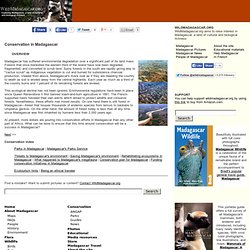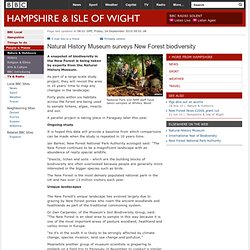

Home — The Amazon Conservation Team. Why are we a nation of tree-huggers? 3 February 2011Last updated at 15:44 By Jon Kelly BBC News Magazine Plans to transfer ownership of many public forests in England have provoked a huge row.

But why are we so protective of our woodlands? It's about the rustling of the leaves and the crunch of twigs underfoot. It's the sensation of the rough bark on your hands and the light dappling into a clearing. Above all, it's a place where nature takes priority over humans. For the vast majority of us, living in towns and cities, visiting a forest is the easiest way to escape our mechanised, wipe-clean, ring-roaded civilisation and properly get back to nature.
As the government is finding out, a forest unleashes something deeply primordial in otherwise domesticated, suburban Britons. Plans to radically change the ownership of some of England's forests have provoked a furious backlash. Indeed, it is a response that tells us much about a country in which 90% of the population live in urban areas. Continue reading the main story. National Geographic - Inspiring People to Care About the Planet Since 1888. Home - National Biodiversity Network. Conservation in Madagascar. Madagascar has suffered environmental degradation over a significant part of its land mass.

Forests that once blanketed the eastern third of the island have now been degraded, fragmented, and converted to scrub land. Spiny forests in the south are rapidly giving way to "cactus scrub" as indigenous vegetation is cut and burned for subsistence charcoal production. Viewed from above, Madagascar's rivers look as if they are bleeding the country to death as soil is eroded away from the central highlands. Each year as much as a third of the country burns and 1 percent of its remaining forests are leveled. This ecological decline has not been ignored.
At present, more dollars are pouring into conservation efforts in Madagascar than any other part of Africa. Next >> Conservation index Parks in Madagascar | Madagascar's Parks Service. Animal Info - Madagascar. Global Environment - Biodiversity - Decidious Forest Biome. This biome is found in three separate regions in the northern hemisphere.

The types of trees you can find in these three regions are broad leafed deciduous trees and some of the evergreen species. The trees are more commonly known as ash, beech, birch and northern arrowwood. Also found in this biome are wild flowers such as oxlip, bluebells, painted trillium and primrose. As well as things such as carpet moss, tawny milk-cap mushrooms and lady fern. The soil is very fertile. There are many types of animals in the deciduous forest ranging from mammals like deer to bugs like mosquitoes.
A few common animals found in the deciduous forest are, deer, gray squirrels, mice raccoons, salamanders, snakes, robins, frogs and many types of insects. Most deciduous forests are found in Eastern North America somewhere around 35-48° N, and Europe and Asia around 45-60° N. The average temperature is around 50° F (about 10° C). Forest Biodiversity. BBC - Natural History Museum surveys New Forest biodiversity. A snapshot of biodiversity in the New Forest is being taken by experts from the Natural History Museum.

As part of a large-scale study project, they will revisit the area in 10 years' time to map any changes in the landscape. Forty plots within six habitats across the forest are being used to sample lichens, algae, insects and soil. A parallel project is taking place in Paraguay later this year. Ongoing study It is hoped this data will provide a baseline from which comparisons can be made when the study is repeated in 10 years time. Ian Barker, New Forest National Park Authority ecologist said: "The New Forest continues to be a magnificent landscape with an abundance of really special wildlife.
"Insects, lichen and soils - which are the building blocks of biodiversity are often overlooked because people are generally more interested in the bigger species such as birds. The New Forest is the most densely populated national park in the UK and has over 13 million visitors each year. Ocean Biogeographic Information System. Marine Barcode of Life Initiative. CReefs- Census of Coral Reef Ecosystems. Home, Arctic Ocean biodiversity.